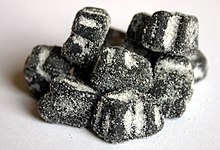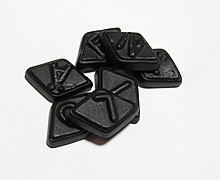
Finnish cuisine is notable for generally combining traditional country fare and haute cuisine with contemporary continental-style cooking. Fish and meat play a prominent role in traditional Finnish dishes in some parts of the country, while the dishes elsewhere have traditionally included various vegetables and mushrooms. Evacuees from Karelia contributed to foods in other parts of Finland in the aftermath of the Continuation War.

Liquorice or licorice is the common name of Glycyrrhiza glabra, a flowering plant of the bean family Fabaceae, from the root of which a sweet, aromatic flavouring is extracted.

Ammonium chloride is an inorganic chemical compound with the chemical formula NH4Cl, also written as [NH4]Cl. It is an ammonium salt of hydrogen chloride. It consists of ammonium cations [NH4]+ and chloride anions Cl−. It is a white crystalline salt that is highly soluble in water. Solutions of ammonium chloride are mildly acidic. In its naturally occurring mineralogic form, it is known as sal ammoniac. The mineral is commonly formed on burning coal dumps from condensation of coal-derived gases. It is also found around some types of volcanic vents. It is mainly used as fertilizer and a flavouring agent in some types of liquorice. It is a product of the reaction of hydrochloric acid and ammonia.
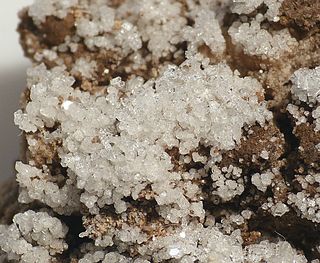
Salammoniac, also sal ammoniac or salmiac, is a rare naturally occurring mineral composed of ammonium chloride, NH4Cl. It forms colorless, white, or yellow-brown crystals in the isometric-hexoctahedral class. It has very poor cleavage and is brittle to conchoidal fracture. It is quite soft, with a Mohs hardness of 1.5 to 2, and it has a low specific gravity of 1.5. It is water-soluble. Sal ammoniac is also the archaic name for the chemical compound ammonium chloride.

Fisherman's Friend is a brand of strong menthol lozenges manufactured by the Lofthouse company in Fleetwood, Lancashire, England.

Salmiakki Koskenkorva, is a pre-mixed liqueur popular in Finland. Traditionally, the cocktail consisted of Koskenkorva Viina vodka with salmiakki extract dissolved into it. Sometimes, ground-up Tyrkisk Peber is used instead of the extract.
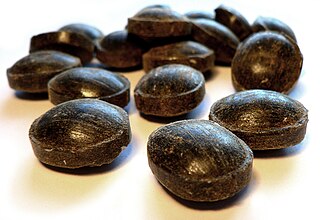
Tyrkisk peber is a salty liquorice candy flavoured with salmiac, produced by the Finnish company Fazer and popular in Northern Europe.

Wine gums are chewy, firm pastille-type sweets originating from the United Kingdom. All brands have their own recipes containing various sweeteners, flavourings and colourings. Wine gums are popular in the United Kingdom, Canada, Ireland, South Africa and many Commonwealth nations, as well as several European countries. Common brands include Maynards, Bassett's, Haribo and Lion.

Liquorice or licorice is a confection usually flavoured and coloured black with the extract of the roots of the liquorice plant Glycyrrhiza glabra.

Orkla ASA is a Norwegian conglomerate operating in Europe, Asia and the US. At present, Orkla operates in the branded consumer goods, aluminium solutions and financial investment sectors. Orkla ASA is listed on the Oslo Stock Exchange and its head office is in Oslo, Norway. As of 31 December 2021, Orkla had 21,423 employees. The Group's turnover in 2021 totalled NOK 50.4 billion.
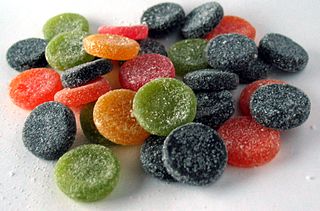
Pantteri, sold in Sweden as Katten, is a brand of Finnish salmiakki candy, made by Fazer.
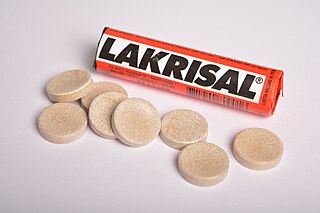
Lakrisal is a Malaco brand of salty liquorice sold in the Nordic countries and the Netherlands.
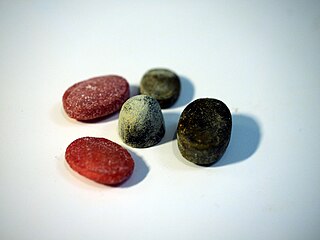
Dracula Piller are a brand of salmiakki confectionery. They are very popular in Denmark and Finland.

Apteekin Salmiakki is a lozenge-shaped hard candy brand of salmiakki, or salty liquorice candy, made by the Finnish company Haganol. "Salmiac" is a term for ammonium chloride, one of the principal flavourings in salty liquorice.
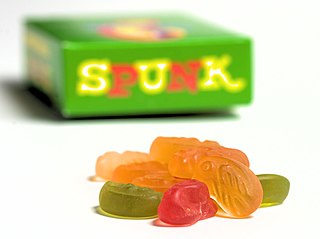
Spunk is a brand of Danish candy, launched in 1971 by Danish candy manufacturers Galle & Jessen and commonly sold in Denmark and Germany.

Sisu is a Finnish brand of candy, currently produced by Leaf International.

Pirate coins are salty liquorice flavoured candies popular in Europe, especially the Nordic countries. The candies are coin-shaped and feature images associated with pirates, such as guns, skull and crossbones symbols, and parrots.

Oy Merijal Ab was a Finnish candy factory based in Oulu.
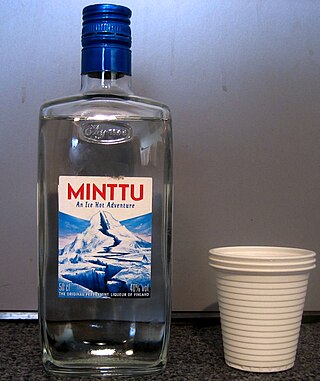
Minttu is a Finnish brand of peppermint-flavoured liqueur produced by Pernod Ricard. A characteristic ingredient of the liqueur is peppermint, to give a fresh taste and aroma.

Aakkoset is a Finnish brand of candy sold in Finland since 1970, currently sold by Cloetta under the Malaco brand name. The name "Aakkoset" comes from the various capital letters of the alphabet decorating the lozenge-shaped candies.
